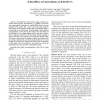Free Online Productivity Tools
i2Speak
i2Symbol
i2OCR
iTex2Img
iWeb2Print
iWeb2Shot
i2Type
iPdf2Split
iPdf2Merge
i2Bopomofo
i2Arabic
i2Style
i2Image
i2PDF
iLatex2Rtf
Sci2ools
173
click to vote
FDTC
2011
Springer
2011
Springer
An In-depth and Black-box Characterization of the Effects of Clock Glitches on 8-bit MCUs
Abstract—The literature about fault analysis typically describes fault injection mechanisms, e.g. glitches and lasers, and cryptanalytic techniques to exploit faults based on some assumed fault model. Our work narrows the gap between both topics. We thoroughly analyse how clock glitches affect a commercial low-cost processor by performing a large number of experiments on five devices. We observe that the effects of fault injection on two-stage pipeline devices are more complex than commonly reported in the literature. While injecting a fault is relatively easy, injecting an exploitable fault is hard. We further observe that the easiest to inject and reliable fault is to replace instructions, and that random faults do not occur. Finally, we explain how typical fault attacks can be mounted on this device, and we describe a new attack for which the fault injection is easy and the cryptanalysis trivial. Keywords-Fault effect characterization; AVR MCU; clock glitches
| Added | 20 Dec 2011 |
| Updated | 20 Dec 2011 |
| Type | Journal |
| Year | 2011 |
| Where | FDTC |
| Authors | Josep Balasch, Benedikt Gierlichs, Ingrid Verbauwhede |
Comments (0)

